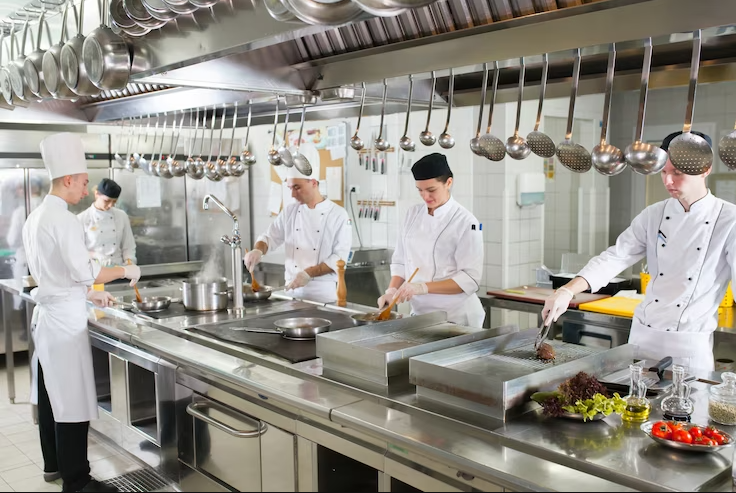Blog
Professional Kitchen Equipment Through Time: From Fire to Innovation
The evolution of professional kitchen equipment has played a crucial role in shaping the culinary landscape throughout history. From the early days of cooking over an open fire to the sophisticated, high-tech appliances of today, the development of kitchen equipment has revolutionized the way chefs prepare and present food. Let’s take a journey through time to explore the remarkable progression of professional kitchen equipment.
Primitive Tools: The earliest kitchens relied on simple tools made from stone, wood, and clay. Fire played a central role in cooking, with food being roasted or boiled in rudimentary pots and pans. Stone tools were used for grinding grains and crushing herbs, while wooden utensils assisted with stirring and mixing ingredients.
 Advancements in Cookware: As civilizations progressed, advancements in metallurgy led to the use of bronze, copper, and iron for cookware. These materials allowed for more efficient heat distribution and improved cooking techniques. Cookware such as cauldrons, griddles, and pans became common in professional kitchens, enabling chefs to prepare a wider variety of dishes.
Advancements in Cookware: As civilizations progressed, advancements in metallurgy led to the use of bronze, copper, and iron for cookware. These materials allowed for more efficient heat distribution and improved cooking techniques. Cookware such as cauldrons, griddles, and pans became common in professional kitchens, enabling chefs to prepare a wider variety of dishes.
Industrial Revolution: The advent of the Industrial Revolution in the 18th century brought about significant changes in kitchen equipment. With the introduction of steam power, cooking methods evolved. Large steam-powered ovens and ranges replaced open hearths, increasing efficiency and control over cooking temperatures. The development of cast iron stoves further improved heat regulation, making cooking more precise.
Electric and Gas Appliances: The late 19th and early 20th centuries witnessed the emergence of electric and gas-powered kitchen appliances. The invention of the electric oven and stovetop brought convenience and precise temperature control to professional kitchens. Gas-powered ranges offered an alternative, providing instant heat and flexibility in cooking.
Introduction of Refrigeration: The introduction of mechanical refrigeration in the late 19th century revolutionized food storage and preservation. Refrigerators and freezers allowed chefs to store perishable ingredients for longer periods, ensuring freshness and minimizing food waste. Cold storage also enabled the creation of chilled desserts and the development of ice cream as a popular treat.
Technological Advancements: The latter half of the 20th century saw rapid advancements in kitchen technology. Microwave ovens brought speed and convenience to heating and cooking, while food processors and blenders revolutionized the preparation of ingredients. Sous vide machines, immersion circulators, and induction cooktops emerged, offering precise control over cooking temperatures and methods.
 High-Tech Innovations: In recent decades, the culinary world has witnessed the rise of high-tech kitchen equipment. Commercial-grade combi-ovens combine convection, steam, and even microwave functionalities into a single unit, offering chefs a wide range of cooking techniques in one appliance. Vacuum sealers, immersion blenders, and molecular gastronomy tools have become staples in professional kitchens, allowing chefs to experiment with new textures and flavor combinations.
High-Tech Innovations: In recent decades, the culinary world has witnessed the rise of high-tech kitchen equipment. Commercial-grade combi-ovens combine convection, steam, and even microwave functionalities into a single unit, offering chefs a wide range of cooking techniques in one appliance. Vacuum sealers, immersion blenders, and molecular gastronomy tools have become staples in professional kitchens, allowing chefs to experiment with new textures and flavor combinations.
Connectivity and Automation: With the advent of the Internet of Things (IoT) and smart technology, professional kitchen equipment has become increasingly connected and automated. Commercial kitchens now feature intelligent ovens, refrigerators with temperature monitoring systems, and automated cooking systems. These innovations streamline operations, improve efficiency, and provide chefs with real-time data and control over their kitchen processes.
The evolution of professional kitchen equipment has not only made cooking more efficient but has also influenced the culinary industry’s creativity and possibilities. Chefs now have access to a wide array of tools and appliances that enhance their skills, expand their culinary repertoire, and bring new dining experiences to life.
As we look toward the future, it’s exciting to envision how technology will continue to shape professional kitchen equipment. With advancements in robotics, artificial intelligence, and sustainable practices, we can expect further innovations that will redefine the art of cooking and push the boundaries of culinary excellence.

 Español
Español
